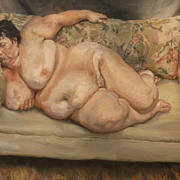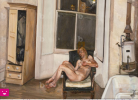The Icon Envailed
Created by Kylie Hollister on Tue, 04/02/2024 - 14:51

Freud, Lucian. “Benefits Supervisor Sleeping.” Wikipedia, 1995, https://en.wikipedia.org/wiki/Benefits_Supervisor_Sleeping#/media/File:B.... Accessed 3 April 2024.
This timeline provides a sociohistorical context for Lucian Freud1995 Benefits Supervisor Sleeping.
Timeline
Chronological table
| Date | Event | Created by | Associated Places | |
|---|---|---|---|---|
| 1960 |
From soft brushes to hard brushes.Lucian Freud was an artist who focused on realism. One of the shifts in his artistic career was changing his stance while painting and the type of brushes he used. Freud got extremely agitated sitting down and not being able to move freely. Another thing that was agitating him was the brushstrokes he was currently using were not allowing him to paint the image the way he imagined. So when he changed the type of brush from soft sable brushes too hard hog hair ones that he would cut down to the end it allowed him to create more definite streaks in certain places to give the painting more dimension. The event ties together with the image because, during the 80’s and 90’s, Freud was using this new technique which contrasted his earlier paintings and made his paintings more realistic. Without this new technique, the viewers may not have been able to see the curves in her body beyond her extra fluffiness; without this, they may have interpreted the painting completely differently. The 1950s was a period when the pre-avant-garde movements and abstract expressionism were in the air which caused many artists to move due to events that were offered but they were also in unlivable conditions. The 1950s is significant to this event because this could have been another reason why Freud became agitated and felt he needed to change his brush technique.
Works cited: Kamp, David. “Psychoanalyzing Lucian Freud.” Vanity Fair, 16 January 2012, https://www.vanityfair.com/culture/2012/02/freud-201202. Accessed 1 April 2024. Freud, Lucian, and Caroline Blackwood. “Lucian Freud Paintings, Bio, Ideas | TheArtStory.” The Art Story, 7 May 2016, https://www.theartstory.org/artist/freud-lucian/. Accessed 16 March 2024. Farrell, Jennifer. “Existentialism and Abstraction: Etchings by Lucian Freud and Brice Marden.” The Metropolitan Museum of Art, 18 August 2015, https://www.metmuseum.org/articles/existentialism-and-abstraction. Accessed 16 March 2024. Calvert, Stella. “Lucian Freud's Work Through the Decades – bridgeman blog.” Bridgeman Images Blog, 22 May 2019, https://blog.bridgemanimages.com/blog/lucian-freuds-work-through-the-dec.... Accessed 16 March 2024. |
Kylie Hollister | ||
| 1982 |
Bowery and TilleySue Tilley was a benefits supervisor when she became famous for being painted by Lucian Freud. Although she worked for the government, she also believed in the rights of the LGBTQ community, which society did not frown upon. She was friends with Leigh Bowery who was a trans, gay rights activist who was also a model for Lucian Freud. Bowery also owned a nightclub called “Nightclub Taboo”. Tilley and Bowery met in 1982 at a nightclub but after they met she began working at the nightclub Bowery owned as a cashier. The nightclub Taboo was known for allowing individuals to embrace their sexuality in a confined space but also to embrace polysexual identities. Bowery caught Lucian's attention by the way he “took the New Romantic penchant for dressing up to the level of art” according to The Last Tuesday Society. Bowery then introduced Sue Tilley to Lucian Freud. The event shows Sue Tilley was not one to follow in society's footsteps but rather explore the boundaries she can push to see what society can accept. At this time many paintings were of slim women with a female gaze upon the viewer to show sexualization towards the female. This painting of Sue Tilley is of a woman who wants the viewers to see she is comfortable enough in her flesh to seem like she is falling asleep completely nude knowing she is being gazed upon while also not looking like many of society's models. Another significant event at this time was the legalization of LGBTQ rights. For instance, during the 1980’s many individuals were trying to lower the age of consensual sex for gay individuals along with many other movements and rights being affected.
Works cited Hale, Amy. “Leigh Bowery: The Life and Times of an Icon by Sue Tilley.” The Last Tuesday Society, 4 September 2022, https://www.thelasttuesdaysociety.org/event/leigh-bowery-the-life-and-ti.... Accessed 1 April 2024.
|
Kylie Hollister | ||
| 1990 |
The bond of Sue Tilley and Lucian FreudThe relationship between Sue Tilley and Lucian Freud is an interesting one. The both of them would work long days with each other when creating a painting so they would go to lunch sometimes along with having friendly conversations while working. Many individuals would assume they would be in a romantic relationship but in reality, they were only friends. Sue Tilley said in an interview “ he made me laugh so hard sometimes I would almost fall off the couch.” This is just one of many examples showing that Freud and Tilley were friends while she modeled for this painting. Their relationship ties together with the painting because everyone would think their friendship made it easier and comfortable for her to sit through long periods completely nude. Even though they did have a good relationship while she modeled for him, a statement made by Tilley about Freud’s characteristics led their friendship to come to an end. Even though this happened after she modeled for him it shows that Sue Tilley is a strong individual and dealt with a lot of criticism over the years and dealt with difficulties from many powerful males but that did not stop her from wanting to continue going against the norms of society and create her own. Vanduffel, Dirk. “Freud's Muse Susan Tilley Tells About Her Years With The Artist.” ArtDependence, 18 September 2018, https://artdependence.com/articles/freuds-muse-susan-tilley-tells-about-.... Accessed 16 March 2024. Laux, Cameron. “Lucian Freud and Sue Tilley: The story of an unlikely muse.” BBC, 14 May 2018, https://www.bbc.com/culture/article/20180514-lucian-freud-and-big-sue-th.... Accessed 16 March 2024. Art Scene Athens. “Interview with Sue Tilley: Art antics, diverse life experiences and Freud.” art scene athens, 26 June 2020, https://artsceneathens.com/2020/06/26/interview-with-sue-tilley-art-anti.... Accessed 16 March 2024.
|
Kylie Hollister | ||
| 2 Apr 2024 |
The wrap upThe reason that I offered that background concerning those three events is that it helps me to explain what Benefits Supervisor Sleeping was doing socially and politically when Lucian Freud created it. Lucian Freud had just altered his brushstroke technique before painting this image by swapping his soft brushes for hard brushes that he would cut down to provide realism when drawing the human body. Meaning he wanted the fat rolls and the curves of her body to be seen more precisely than he was previously doing. The object of the image is Sue Tilley who appeared to be sleeping on the couch completely nude. She was an activist for the LGBTQ and was also friends with Leigh Bowery. Leigh Bowery was also a gay activist who owned a nightclub club Taboo that was focused around gays and polysexual identities. The two of them were known for pushing the boundaries of what society would accept which is exactly what this painting represents too. The supervisor appeared to be sleeping nude while also not as skinny as many of the models society was used to seeing. Along with Sue Tilley painted in a position as if when she wakes up she is ready to take on any challenges that come her way. The reason I say this is, that her legs are positioned slightly off the couch looking as if she is ready to stand up quickly if needed. The couch itself is positioned in a forward manner looking as if it is trying to push Tilley off of the couch. Since Tilley is an activist this symbolization has significant meaning because it shows not only through the object herself but from the position of the object and the other objects that Tilley is ready to face whatever is being thrown at her. The image represents many boundaries it can push in the artistic community. From the change in brushstrokes to making the image curves in the body more definite, to the object herself being known for hanging out with Bowery who is known for his participation in the LGBTQ community. |
Kylie Hollister |



